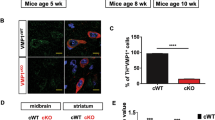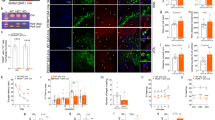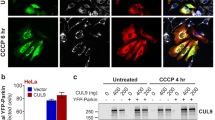Abstract
Mice heterozygous for the homeobox gene Engrailed-1 (En1) display progressive loss of mesencephalic dopaminergic (mDA) neurons. We report that exogenous Engrailed-1 and Engrailed-2 (collectively Engrailed) protect mDA neurons from 1-methyl-4-phenyl-1,2,3,6-tetrahydropyridine (MPTP), a mitochondrial complex I toxin used to model Parkinson's disease in animals. Engrailed enhances the translation of nuclearly encoded mRNAs for two key complex I subunits, Ndufs1 and Ndufs3, and increases complex I activity. Accordingly, in vivo protection against MPTP by Engrailed is antagonized by Ndufs1 small interfering RNA. An association between Engrailed and complex I is further confirmed by the reduced expression of Ndufs1 and Ndufs3 in the substantia nigra pars compacta of En1 heterozygous mice. Engrailed also confers in vivo protection against 6-hydroxydopamine and α-synuclein-A30P. Finally, the unilateral infusion of Engrailed into the midbrain increases striatal dopamine content, resulting in contralateral amphetamine-induced turning. Therefore, Engrailed is both a survival factor for adult mDA neurons and a regulator of their physiological activity.
This is a preview of subscription content, access via your institution
Access options
Subscribe to this journal
Receive 12 print issues and online access
$209.00 per year
only $17.42 per issue
Buy this article
- Purchase on Springer Link
- Instant access to full article PDF
Prices may be subject to local taxes which are calculated during checkout







Similar content being viewed by others
References
Dauer, W. & Przedborski, S. Parkinson's disease: mechanisms and models. Neuron 39, 889–909 (2003).
Dawson, T.M. & Dawson, V.L. Molecular pathways of neurodegeneration in Parkinson's disease. Science 302, 819–822 (2003).
Schapira, A.H. Mitochondria in the aetiology and pathogenesis of Parkinson's disease. Lancet Neurol. 7, 97–109 (2008).
Ang, S.L. Transcriptional control of midbrain dopaminergic neuron development. Development 133, 3499–3506 (2006).
Albéri, L., Sgadò, P. & Simon, H. Engrailed genes are cell-autonomously required to prevent apoptosis in mesencephalic dopaminergic neurons. Development 131, 3229–3236 (2004).
Hanks, M., Wurst, W., Anson-Cartwright, L., Auerbach, A.B. & Joyner, A.L. Rescue of the En-1 mutant phenotype by replacement of En-1 with En-2. Science 269, 679–682 (1995).
Sonnier, L. et al. Progressive loss of dopaminergic neurons in the ventral midbrain of adult mice heterozygote for Engrailed1. J. Neurosci. 27, 1063–1071 (2007).
Prochiantz, A. & Joliot, A. Can transcription factors function as cell-cell signalling molecules? Nat. Rev. Mol. Cell Biol. 4, 814–819 (2003).
Brunet, I. et al. The transcription factor Engrailed-2 guides retinal axons. Nature 438, 94–98 (2005).
Wizenmann, A. et al. Extracellular Engrailed participates in the topographic guidance of retinal axons in vivo. Neuron 64, 355–366 (2009).
Richter, J.D. & Klann, E. Making synaptic plasticity and memory last: mechanisms of translational regulation. Genes Dev. 23, 1–11 (2009).
Nédélec, S. et al. Emx2 homeodomain transcription factor interacts with eukaryotic translation initiation factor 4E (eIF4E) in the axons of olfactory sensory neurons. Proc. Natl. Acad. Sci. USA 101, 10815–10820 (2004).
Topisirovic, I. & Borden, K.L.B. Homeodomain proteins and eukaryotic translation initiation factor 4E (eIF4E): an unexpected relationship. Histol. Histopathol. 20, 1275–1284 (2005).
Di Nardo, A.A. et al. Dendritic localization and activity-dependent translation of Engrailed1 transcription factor. Mol. Cell. Neurosci. 35, 230–236 (2007).
Alvarez-Fischer, D. et al. Characterization of the striatal 6-OHDA model of Parkinson's disease in wild type and alpha-synuclein-deleted mice. Exp. Neurol. 210, 182–193 (2008).
Recchia, A. et al. Generation of a alpha-synuclein-based rat model of Parkinson's disease. Neurobiol. Dis. 30, 8–18 (2008).
Höglinger, G.U. et al. Chronic systemic complex I inhibition induces a hypokinetic multisystem degeneration in rats. J. Neurochem. 84, 491–502 (2003).
Marc, P. et al. Genome-wide analysis of mRNAs targeted to yeast mitochondria. EMBO Rep. 3, 159–164 (2002).
Ricci, J.E. et al. Disruption of mitochondrial function during apoptosis is mediated by caspase cleavage of the p75 subunit of complex I of the electron transport chain. Cell 117, 773–786 (2004).
Dieteren, C.E. et al. Subunits of mitochondrial complex I exist as part of matrix- and membrane-associated subcomplexes in living cells. J. Biol. Chem. 283, 34753–34761 (2008).
De Toni, A. et al. Regulation of survival in adult hippocampal and glioblastoma stem cell lineages by the homeodomain-only protein HOP. Neural Dev. 3, 13 (2008).
Joliot, A. & Prochiantz, A. Transduction peptides: from technology to physiology. Nat. Cell Biol. 6, 189–196 (2004).
Fuchs, J. et al. The transcription factor PITX3 is associated with sporadic Parkinson's disease. Neurobiol. Aging 30, 731–738 (2009).
Haubenberger, D. et al. Association of transcription factor polymorphisms PITX3 and EN1 with Parkinson's disease. Neurobiol. Aging 32, 302–307 (2011).
Flanagan, J.G. Neural map specification by gradients. Curr. Opin. Neurobiol. 16, 59–66 (2006).
Boldogh, I.R. & Pon, L.A. Mitochondria on the move. Trends Cell Biol. 17, 502–510 (2007).
Abou-Sleiman, P.M., Muqit, M.M. & Wood, N.W. Expanding insights of mitochondrial dysfunction in Parkinson's disease. Nat. Rev. Neurosci. 7, 207–219 (2006).
Iaccarino, C. et al. Apoptotic mechanisms in mutant LRRK2-mediated cell death. Hum. Mol. Genet. 16, 1319–1326 (2007).
Bénit, P. et al. Mutant NDUFS3 subunit of mitochondrial complex I causes Leigh syndrome. J. Med. Genet. 41, 14–17 (2004).
Iuso, A. et al. Dysfunctions of cellular oxidative metabolism in patients with mutations in the NDUFS1 and NDUFS4 genes of complex I. J. Biol. Chem. 281, 10374–10380 (2006).
Ekstrand, M.I. et al. Progressive parkinsonism in mice with respiratory-chain-deficient dopamine neurons. Proc. Natl. Acad. Sci. USA 104, 1325–1330 (2007).
De Vos, K.J., Grierson, A.J., Ackerley, S. & Miller, C.C. Role of axonal transport in neurodegenerative diseases. Annu. Rev. Neurosci. 31, 151–173 (2008).
Brundin, P., Li, J.Y., Holton, J.L., Lindvall, O. & Revesz, T. Research in motion: the enigma of Parkinson's disease pathology spread. Nat. Rev. Neurosci. 9, 741–745 (2008).
Kadkhodaei, B. et al. Nurr1 is required for maintenance of maturing and adult midbrain dopamine neurons. J. Neurosci. 29, 15923–15932 (2009).
Chung, C.Y. et al. The transcription factor orthodenticle homeobox 2 influences axonal projections and vulnerability of midbrain dopaminergic neurons. Brain 133, 2022–2031 (2010).
Di Salvio, M. et al. Otx2 controls neuron subtype identity in ventral tegmental area and antagonizes vulnerability to MPTP. Nat. Neurosci. 13, 1481–1488 (2010).
Torero Ibad, R. et al. Otx2 promotes the survival of damaged adult retinal ganglion cells and protects against excitotoxic loss of visual acuity in vivo. J. Neurosci. 31, 5495–5503 (2011).
Joshi, R.L. et al. Cell non-autonomous functions of homeoproteins in neuroprotection in the brain. FEBS Lett. 585, 1573–1578 (2011).
Topisirovic, I. et al. Eukaryotic translation initiation factor 4E activity is modulated by HOXA9 at multiple levels. Mol. Cell. Biol. 25, 1100–1112 (2005).
Wegrzyn, J. et al. Function of mitochondrial Stat3 in cellular respiration. Science 323, 793–797 (2009).
She, H. et al. Direct regulation of complex I by mitochondrial MEF2D is disrupted in a mouse model of Parkinson disease and in human patients. J. Clin. Invest. 121, 930–940 (2011).
Tatton, N.A. & Kish, S.J. In situ detection of apoptotic nuclei in the substantia nigra compacta of 1-methyl-4-phenyl-1,2,3,6-tetrahydropyridine-treated mice using terminal deoxynucleotidyl transferase labelling and acridine orange staining. Neuroscience 77, 1037–1048 (1997).
Franklin, K.B.J. & Paxinos, G. The Mouse Brain in Stereotaxic Coordinates (Academic Press, 1997).
Salthun-Lassalle, B., Hirsch, E.C., Wolfart, J., Ruberg, M. & Michel, P.P. Rescue of mesencephalic dopaminergic neurons in culture by low-level stimulation of voltage-gated sodium channels. J. Neurosci. 24, 5922–5930 (2004).
Kawamoto, J.C. & Barrett, J.N. Cryopreservation of primary neurons for tissue culture. Brain Res. 384, 84–93 (1986).
Douhou, A., Troadec, J.D., Ruberg, M., Raisman-Vozari, R. & Michel, P.P. Survival promotion of mesencephalic dopaminergic neurons by depolarizing concentrations of K+ requires concurrent inactivation of NMDA or AMPA/kainite receptors. J. Neurochem. 78, 163–174 (2001).
Hirsch, E., Graybiel, A.M. & Agid, Y.A. Melanized dopaminergic neurons are differentially susceptible to degeneration in Parkinson's disease. Nature 334, 345–348 (1988).
Hollingsworth, E.B. et al. Biochemical characterization of a filtered synaptoneurosome preparation from guinea pig cerebral cortex: cyclic adenosine 3′:5′-monophosphate-generating systems, receptors, and enzymes. J. Neurosci. 5, 2240–2253 (1985).
Villasana, L.E., Klann, E. & Tejada-Simon, M.V. Rapid isolation of synaptoneurosomes and postsynaptic densities from adult mouse hippocampus. J. Neurosci. Methods 158, 30–36 (2006).
Iancu, R., Mohapel, P., Brundin, P. & Paul, G. Behavioral characterization of a unilateral 6-OHDA-lesion model of Parkinson's disease in mice. Behav. Brain Res. 162, 1–10 (2005).
Acknowledgements
This work was supported by Agence Nationale pour la Recherche (ANR-06-013-01), the Michael. J. Fox Foundation (MJFF), Fondation de France (Physiopathology of Parkinson disease) and the European Community (FP7 222999, mdDANeurodev project). D.A.-F. was funded by the MJFF, the University Medical Center Giessen and Marburg (UKGM) and the German Academic Exchange Service (DAAD). The CIRB group is part of a Global Research Laboratory (KAIST, South Korea) and a Foundation for Medical Research (FRM) team. J.F. was funded by the German Research Foundation (DFG), the MJFF, FRM and NERF (Neuropôle de Recherche Francilien). A.H. was temporarily supported by INSERM. We thank E. Ipendey for technical help. Confocal imaging and quantification were performed by V. Mignon and B. Saubaméa. We thank the Laboratory of Mass Spectrometry and Proteomics, Institut Curie for assistance. We are indebted to A. Prigent, E. Hirsch, P. Michel and M. Volovitch for intellectual input.
Author information
Authors and Affiliations
Contributions
A.P. proposed the initial hypothesis that Engrailed could be used as a protective protein in animal models of Parkinson's disease. D.A.-F., J.F., F.C., O.M.-B. and R.L.J. performed experiments to study Engrailed survival activity. O.S., C.B., K.L.M., J.F., O.M.-B. and R.L.J. examined Engrailed translational targets. W.F. helped with mass spectroscopy. A.L. measured complex I activity. W.H.O. participated in discussions. J.F., D.A.-F., R.L.J., A.H. and A.P. designed the experiments and interpreted the results. D.A.-F., J.F., R.L.J. and A.P. wrote the manuscript.
Corresponding authors
Ethics declarations
Competing interests
The authors declare no competing financial interests.
Supplementary information
Supplementary Text and Figures
Supplementary Figures 1–6 (PDF 1237 kb)
Rights and permissions
About this article
Cite this article
Alvarez-Fischer, D., Fuchs, J., Castagner, F. et al. Engrailed protects mouse midbrain dopaminergic neurons against mitochondrial complex I insults. Nat Neurosci 14, 1260–1266 (2011). https://doi.org/10.1038/nn.2916
Received:
Accepted:
Published:
Issue Date:
DOI: https://doi.org/10.1038/nn.2916
This article is cited by
-
Orthodenticle homeobox 2 is transported to lysosomes by nuclear budding vesicles
Nature Communications (2023)
-
Maintenance of mitochondrial integrity in midbrain dopaminergic neurons governed by a conserved developmental transcription factor
Nature Communications (2022)
-
Genetic targeting of adult Renshaw cells using a Calbindin 1 destabilized Cre allele for intersection with Parvalbumin or Engrailed1
Scientific Reports (2021)
-
Increased gene expression variability in BRCA1-associated and basal-like breast tumours
Breast Cancer Research and Treatment (2021)
-
Transcription Factors: Potential Cell Death Markers in Parkinson’s Disease
Neuroscience Bulletin (2017)



